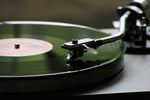
The difference between a turntable and record player
, by Haim Deutsch, 5 min reading time

, by Haim Deutsch, 5 min reading time
When you start your adventure into vinyl, one of the first things you’ll come across will be that the device you put records on is called both a turntable and a record player. The terms turntable and record player are regularly confused for one another, but there is a distinct difference. This can be confusing, as both devices do the same thing - play records on a turning table.
Turntable vs. Record Player
When you start your adventure into vinyl, one of the first things you’ll come across will be that the device you put records on is called both a turntable and a record player. The terms turntable and record player are regularly confused for one another, but there is a distinct difference. This can be confusing, as both devices do the same thing - play records on a turning table.
Below, we define the two, and weigh up the advantages and disadvantages of each to let you decide whether you should buy a turntable or a record player to best enjoy your growing collection of records.
What is a Turntable?
A traditional turntable needs a preamp, amplifier and speakers to play records. In this case, all the units are standalone components. The turntable reads the grooves that are carved into the record and transform them to a small electrical signal called a Phono signal. The preamp boosts the tiny Phono signal from the turntable so that it can be inputted to an amplifier or receiver. There is often a preamp built into the turntable or the amplifier. The amplifier strengthens the signal further so that it becomes strong enough to drive speakers - Some speakers have the amplifier built-in. The speakers convert the power amplified signal to vibrations - music!
The main components of a turntable and their uses are detailed below:
A turntable with a built-in preamp can be connected to an amplifier/receiver directly, without having to connect a preamp between the turntable and the amplifier/receiver. On most turntables, it is possible to change and upgrade the stylus and cartridge. This comes in handy if the stylus is worn out or if you want to upgrade the cartridge to a higher quality one that produces higher quality sound.
What is a Record Player?
In a record player, all the necessary components (most of them listed in the previous section) are combined in one unit. A record player will include a turntable, preamp, amplifier and speakers; everything is included, no extra boxes or cables are necessary to play records. Usually, there are very few options to change/upgrade components or to fine adjust cartridge alignment and stylus downforce on a record player. All this is usually fixed from the factory.
Which is better?
Advantages of a turntable:
Advantages of a record player:
Conclusion
Basically, if you are a music lover, a turntable is your best bet. The sound quality is leaps and bounds better than a record player, they are more durable and therefore last longer. Although the price difference is stark, the money spent on a turntable goes a long way - record players are destined to break and will need to be replaced when that time comes.